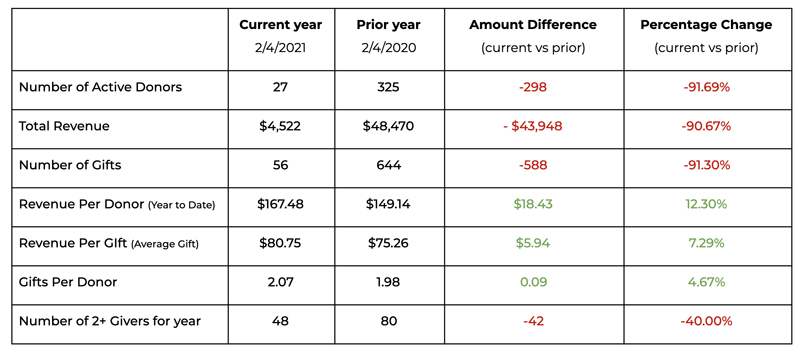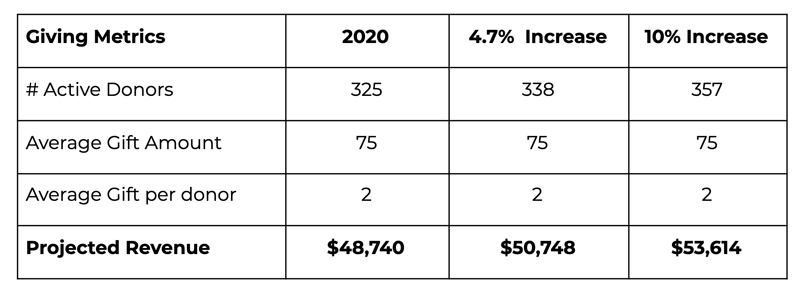
Regardless of your nonprofit’s sector or size, as a fundraiser, you have two main objectives when it comes to increasing individual contributions. First, you need to retain your existing donors. You also need to get new donors to replace the funds from donors you lose. How can you know how many new donors you need this year? What amount and how often will current supporters donate again? To figure this out, we looked at how successful organizations set their fundraising goals. In this article we’ll cover:
- Sample Fundraising Goals for Current and New Donors
- Estimating Revenue from Existing (Active) Donors
- Setting New Donor Acquisition Targets
- FREE WEBINAR: Building a Strong Donor Pool
Sample Fundraising Goals for Current and New Donors
Successful nonprofits, no matter how small, make setting definitive fundraising goals a priority. They go beyond a vague “I want to raise more than last year” goal to set specific targets for their fundraising tasks. They also use their donor data to help them make confident decisions about fundraising targets. This allows them to work smarter and focus their efforts on the critical activities that will grow their giving.
Let’s look at a sample budget for a small nonprofit organization. In our example, the development team needs to raise 88K from individual contributions to meet their fundraising goals. Here’s the breakdown:
Based on its operating budget, this organization needs a total of $150K to meet all its 2021 expenses.
The following revenue is already secured or planned:
- Foundational Grants: 28K
- Corporate Contributions: 7K
- Planned Giving (Wills): 15K
- Merchandise Sales: 2K
- Virtual Events/Auctions: 10K
TOTAL PLANNED REVENUE: $62K
Determining Individual Contributions Needed
The gap between expenses (150K) and planned revenue (62K) is the amount of individual contributions you’d need to raise from supporters. In this case, 150K – 62K = 88K
Philanthropy Outlook, published by the Indiana University Lilly Family School of Philanthropy, predicts that 66.9% of total giving is expected to derive from personal giving, followed by 18.6% from foundations, 9.9% from estates, and 4.7% from corporations in 2021. How does your organization compare to these industry predictions? Review your fundraising revenue sources outside of individual contributions to see where you might have growth opportunities.
What’s the Mix of Current vs. New Donors?
Once you know your fundraising target (e.g., $88K), the next step is to estimate how much of your individual contributions you can expect to come from current donors versus acquiring new donors. Every nonprofit (unless it’s completely new) has a mix of contributions from active (existing) and new donors to meet their fundraising goals. Your donor data can help you determine:
- The exact number of new donors you need
- How many active donors you have, and what they’ll contribute
- How much you should ask supporters for
- How many times a year a donor will give
Estimating Revenue from Existing (Active) Donors
Your fundraising strategy should start with a plan to retain as many donors as possible. It’s easier (and less costly) to keep current donors than to get new donors. Also, on average, retained donors give more than new donors, so your potential for revenue per donor is greater for existing donors than for new donors. This makes sense since donors that have already given to your nonprofit are already engaged with your mission.
Using DonorPerfect’s Comprehensive Donor Revenue Analysis report, you can discover how many active donors have given at least once over the past 12 months. You can also see the average gift amount for existing donors and the average number of gifts given per donor. Use these numbers to estimate the revenue you can expect from active donors and set potential fundraising targets.
Comprehensive Donor Analysis as of 2/4/2020

In the report above, we see that our sample nonprofit has the following:
- 325 active donors
- $75 average gift amount
- Two gifts per donor
Using this data, you could expect to receive $48,470 in donations from your active donors. We multiplied the active donors by the average gift amount and the average number of gifts per donor to calculate this.
ACTIVE DONORS x AVERAGE GIFT AMOUNT x GIFTS PER DONOR = EXPECTED REVENUE
325 donors X $75 per gift x 2 Gifts per year = $48,470
Of course, this is a greatly simplified example of how to estimate active donor revenue. It assumes every donor gives again at the same giving frequency and amount. However, it’s a starting point for where to focus your fundraising efforts and set fundraising targets.
Setting Fundraising Goals For Current Donors
In the chart below, we set two fundraising targets for increasing giving from active donors. Philanthropy Outlook indicates that American individuals/households’ giving is predicted to increase by 4.7% in 2021. Using that percentage, you’d need to have 338 active donors for $50,748 in donations. For a 10% increase in giving, you’d need to have 357 active donors. Tracking the number of active donors is one barometer to know if your giving from active donors is on track.

Setting New Donor Acquisition Targets
Now that we know what you can expect to raise from current donors, you can quickly determine how many new donors you need. As a reminder, our sample nonprofit’s development team needs to raise 88K from individual contributions to meet their fundraising goals. We estimated that $48,470 would come from current donors. How much do you need to raise, and how many new donors will you need to fill the gap?
To find the amount you need to raise, subtract the estimated revenue from current donors from the overall fundraising goal.
$88,000 – $48,470 = $39,530
Since your new donors will likely give at the same level ($75 per gift) and adopt the same giving patterns (2X per year) as previous donors, you can use this data to determine the number of new donors you’ll need. Divide the fundraising target for new donors by the average gift amount times the number of gifts to determine the number of new donors.
AMOUNT / (AVERAGE GIFT AMOUNT x NUMBER OF GIFTS)
39,530/(75 X 2) = 263 donors
DonorPerfect’s Comprehensive Donor Revenue Analysis report can help you monitor your new donor acquisition efforts. At a glance, you’ll see the number of new donors, average gift amount, and an average number of gifts so you can see if you’re on track with acquiring new donors. You can also drill down into the list of new donors to export out for stewardship and follow-up.
The Next Step: Bold Fundraising Goals
There are lots of factors that come into play when determining your fundraising goals. Calculating fundraising targets based on “covering the gap” in your fundraising budget is only a place to start. You also need to consider how much you can raise and how resources like major donor research can help you accomplish more than just “raising more than last year.” Your mission is important and bold. Make your fundraising goals bold too!
WEBINAR: Building a Strong Donor Pool
Where do other organizations find new individual and major donors? If you’ve ever struggled to find and qualify new donors to support your mission, this webinar is for you! Join our panel of nonprofit and fundraising experts as they discuss their donor acquisition strategies. You’ll learn:
- Keys to attracting new supporters
- How to build a major gifts pipeline
- The top prospecting mistakes to avoid





